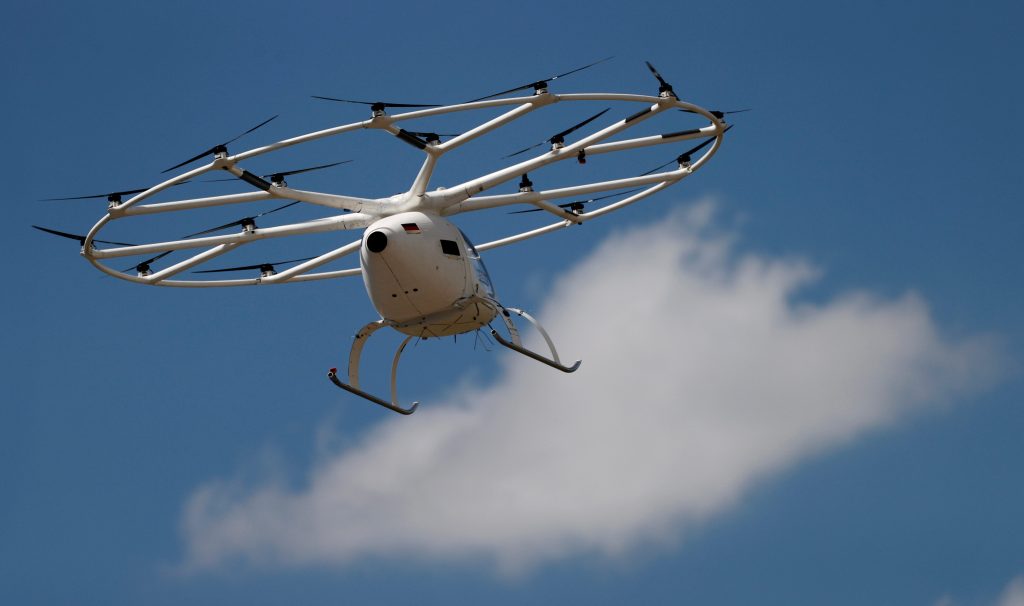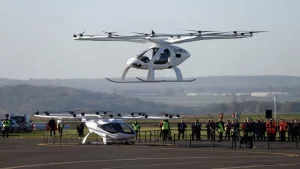Europe’s flying taxi dreams falter as cash runs short
4 min read
A prototype of an electrical air-taxi drone by German start-up Volocopter that takes off and lands vertically performs a non-passenger flight over Le Bourget airport, near Paris, France, June 21, 2021. REUTERS
Europe’s electric flying taxi dreams are facing significant hurdles, with key players in the industry struggling to secure the funding needed to bring their innovations to life. One of the most anticipated projects, Volocopter’s electric flying taxi, was expected to be operational during the Paris Olympics but failed to meet its deadline. Instead of ferrying passengers as planned, the company conducted only demonstration flights. Behind the scenes, Volocopter has been grappling with a financial crisis, working urgently to raise investment to stay afloat.
In April, talks for a €100 million loan from the government fell through. Now, the company’s hopes are pinned on Geely, a Chinese automaker, which is reportedly negotiating to acquire an 85% stake in Volocopter in exchange for $95 million. This deal could result in manufacturing being moved to China. Volocopter is one of many companies worldwide working on electric vertical takeoff and landing (eVTOL) aircraft, which promise to provide the flexibility of helicopters without the high costs, noise, and emissions.
However, despite the hype surrounding eVTOLs, the massive expenses involved in getting such aircraft certified and establishing manufacturing capabilities are proving to be too much for some investors. One of the most high-profile casualties of this trend is Lilium, a German company that had developed a unique eVTOL design featuring 30 electric jets. These jets could tilt to transition between vertical lift and forward flight, offering a radical approach to the concept. Lilium had attracted attention by securing orders for 780 aircraft and was in the process of constructing full-sized jets, with flight tests scheduled to begin in 2025.
Despite this progress, Lilium’s financial troubles surfaced quickly. The company had been working to secure a €100 million loan from Germany’s KfW development bank, but the loan never materialized due to a lack of guarantees from the government. In November, Lilium entered insolvency proceedings, and its shares were removed from the Nasdaq stock exchange. While production on the e-jet continues, the company is now working with restructuring experts to find new investment or sell the business.
Another major European player, Vertical Aerospace, based in Bristol, has also encountered its own setbacks. Founded in 2016 by businessman Stephen Fitzpatrick, the company has developed the VX4 aircraft, which features eight large propellers mounted on sleek, airplane-style wings. Vertical Aerospace made significant progress, moving from remote-controlled tests to piloted trials, with its first untethered takeoff occurring in November. However, the company has faced financial difficulties, including the crash of a prototype in August 2022 and the withdrawal of engineering giant Rolls Royce from a deal to supply electric motors.

Despite these challenges, Vertical Aerospace has secured a $50 million rescue deal with its largest creditor, Mudrick Capital, which will convert $130 million in loans into equity. This deal will leave Mudrick with a 70% stake in the company, diluting Fitzpatrick’s stake to just 20%. Fitzpatrick remains optimistic, asserting that this deal positions Vertical Aerospace to be a leader in the growing eVTOL market.
Amid the financial struggles of these companies, one European project appears to be on a more stable path. Airbus’s CityAirbus NextGen, a four-seater eVTOL aircraft with eight propellers and an 80-kilometer range, is seen as a more financially secure initiative. According to Bjorn Fehrm, an aerospace consultant with a background in aeronautical engineering, Airbus has the resources and expertise to bring this project to fruition.
In contrast, companies in the U.S., such as Joby and Archer, are better funded and also have strong prospects for success. These companies are better positioned to advance their aircraft into production, although the real test will come once these aircraft are operational. The question remains whether a profitable market exists for eVTOLs, particularly as the most likely early routes will connect airports with city centers.
The primary challenges facing the eVTOL industry include the high costs of operation, especially in terms of pilots and batteries. Batteries need to be replaced several times a year, which adds to the operating expenses. Despite these concerns, the industry remains promising, as investors continue to pour money into electric aircraft, hoping to find the next groundbreaking technology, akin to Tesla’s success in electric cars.
As the eVTOL industry evolves, the path forward is uncertain. With ongoing financial struggles and questions about the long-term viability of these aircraft, companies will need to find sustainable ways to overcome the challenges of certification, manufacturing, and profitability. If successful, however, electric flying taxis could revolutionize urban transportation, offering a new era of air travel.





